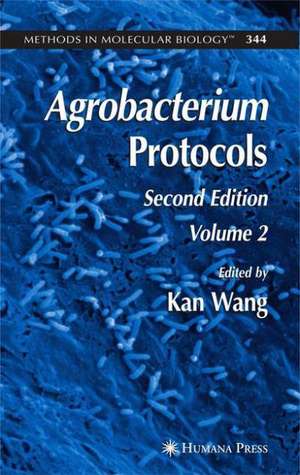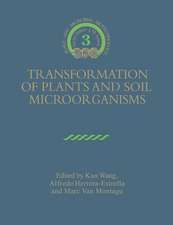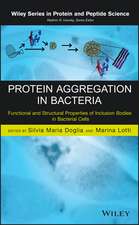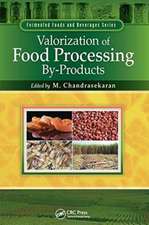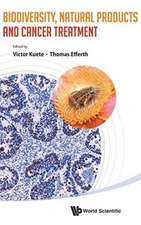Agrobacterium Protocols: Volume II: Methods in Molecular Biology, cartea 344
Editat de Kan Wangen Limba Engleză Paperback – 9 dec 2010
| Toate formatele și edițiile | Preț | Express |
|---|---|---|
| Paperback (4) | 705.83 lei 6-8 săpt. | |
| Springer – 23 aug 2016 | 705.83 lei 6-8 săpt. | |
| Springer – 23 aug 2016 | 785.06 lei 6-8 săpt. | |
| Humana Press Inc. – 9 dec 2010 | 953.52 lei 6-8 săpt. | |
| Humana Press Inc. – 9 dec 2010 | 1225.62 lei 6-8 săpt. | |
| Hardback (4) | 657.73 lei 6-8 săpt. | |
| Springer – 22 noi 2014 | 657.73 lei 6-8 săpt. | |
| Springer – 9 oct 2014 | 960.78 lei 6-8 săpt. | |
| Humana Press Inc. – sep 2006 | 963.15 lei 6-8 săpt. | |
| Humana Press Inc. – iun 2006 | 1235.25 lei 6-8 săpt. |
Din seria Methods in Molecular Biology
- 9%
 Preț: 791.63 lei
Preț: 791.63 lei - 23%
 Preț: 598.58 lei
Preț: 598.58 lei - 20%
 Preț: 882.98 lei
Preț: 882.98 lei -
 Preț: 252.05 lei
Preț: 252.05 lei - 5%
 Preț: 802.70 lei
Preț: 802.70 lei - 5%
 Preț: 729.61 lei
Preț: 729.61 lei - 5%
 Preț: 731.43 lei
Preț: 731.43 lei - 5%
 Preț: 741.30 lei
Preț: 741.30 lei - 5%
 Preț: 747.16 lei
Preț: 747.16 lei - 15%
 Preț: 663.45 lei
Preț: 663.45 lei - 18%
 Preț: 1025.34 lei
Preț: 1025.34 lei - 5%
 Preț: 734.57 lei
Preț: 734.57 lei - 18%
 Preț: 914.20 lei
Preț: 914.20 lei - 15%
 Preț: 664.61 lei
Preț: 664.61 lei - 15%
 Preț: 654.12 lei
Preț: 654.12 lei - 18%
 Preț: 1414.74 lei
Preț: 1414.74 lei - 5%
 Preț: 742.60 lei
Preț: 742.60 lei - 20%
 Preț: 821.65 lei
Preț: 821.65 lei - 18%
 Preț: 972.30 lei
Preț: 972.30 lei - 15%
 Preț: 660.49 lei
Preț: 660.49 lei - 5%
 Preț: 738.41 lei
Preț: 738.41 lei - 18%
 Preț: 984.92 lei
Preț: 984.92 lei - 5%
 Preț: 733.29 lei
Preț: 733.29 lei -
 Preț: 392.60 lei
Preț: 392.60 lei - 5%
 Preț: 746.26 lei
Preț: 746.26 lei - 18%
 Preț: 962.66 lei
Preț: 962.66 lei - 23%
 Preț: 860.22 lei
Preț: 860.22 lei - 15%
 Preț: 652.64 lei
Preț: 652.64 lei - 5%
 Preț: 1055.50 lei
Preț: 1055.50 lei - 23%
 Preț: 883.87 lei
Preț: 883.87 lei - 5%
 Preț: 1141.13 lei
Preț: 1141.13 lei - 19%
 Preț: 491.89 lei
Preț: 491.89 lei - 5%
 Preț: 1038.86 lei
Preț: 1038.86 lei - 5%
 Preț: 524.16 lei
Preț: 524.16 lei - 18%
 Preț: 2122.34 lei
Preț: 2122.34 lei - 5%
 Preț: 1299.23 lei
Preț: 1299.23 lei - 5%
 Preț: 1339.12 lei
Preț: 1339.12 lei - 18%
 Preț: 1390.26 lei
Preț: 1390.26 lei - 18%
 Preț: 1395.63 lei
Preț: 1395.63 lei - 18%
 Preț: 1129.65 lei
Preț: 1129.65 lei - 18%
 Preț: 1408.26 lei
Preț: 1408.26 lei - 18%
 Preț: 1124.92 lei
Preț: 1124.92 lei - 18%
 Preț: 966.27 lei
Preț: 966.27 lei - 5%
 Preț: 1299.99 lei
Preț: 1299.99 lei - 5%
 Preț: 1108.51 lei
Preț: 1108.51 lei - 5%
 Preț: 983.76 lei
Preț: 983.76 lei - 5%
 Preț: 728.16 lei
Preț: 728.16 lei - 18%
 Preț: 1118.62 lei
Preț: 1118.62 lei - 18%
 Preț: 955.25 lei
Preț: 955.25 lei - 5%
 Preț: 1035.62 lei
Preț: 1035.62 lei
Preț: 953.52 lei
Preț vechi: 1162.82 lei
-18% Nou
Puncte Express: 1430
Preț estimativ în valută:
182.48€ • 198.14$ • 153.28£
182.48€ • 198.14$ • 153.28£
Carte tipărită la comandă
Livrare economică 23 aprilie-07 mai
Preluare comenzi: 021 569.72.76
Specificații
ISBN-13: 9781617378034
ISBN-10: 1617378038
Pagini: 512
Ilustrații: 512 p. 87 illus., 6 illus. in color.
Dimensiuni: 152 x 229 x 27 mm
Greutate: 0.68 kg
Ediția:Softcover reprint of hardcover 2nd ed. 2007
Editura: Humana Press Inc.
Colecția Humana
Seria Methods in Molecular Biology
Locul publicării:Totowa, NJ, United States
ISBN-10: 1617378038
Pagini: 512
Ilustrații: 512 p. 87 illus., 6 illus. in color.
Dimensiuni: 152 x 229 x 27 mm
Greutate: 0.68 kg
Ediția:Softcover reprint of hardcover 2nd ed. 2007
Editura: Humana Press Inc.
Colecția Humana
Seria Methods in Molecular Biology
Locul publicării:Totowa, NJ, United States
Public țintă
ResearchCuprins
Root Plants.- Carrot (Daucus carota L.).- Cassava (Manihot esculenta Crantz).- Potato (Solanum tuberosum L.).- Sweet Potato [Ipomoea batatas (L.) Lam.].- Turf Grasses.- Bermudagrass (Cynodon spp.).- Perennial Ryegrass (Lolium perenne L.).- Switchgrass (Panicum virgatum L.).- Tall Fescue (Festuca arundinacea Schreb.).- Turf Grasses.- Woody Species.- American Elm (Ulmus americana).- Cork Oak Trees (Quercus suber L.).- Eucalyptus.- Pine (Pinus radiata).- Poplar (Populus spp.).- Rubber Tree (Hevea brasiliensis Muell. Arg).- Tropic Plants.- Banana (Musa sp.).- Citrus.- Coffee (Coffea sp.).- Papaya (Carica papaya L.).- Pineapple [Ananas comosus (L.) Merr.].- Sugarcane (Saccharum spp.).- Nuts and Fruits.- American Chestnut [Castanea dentata (Marsh.) Borkh.].- Apple (Malus × domestica).- Blueberry (Vaccinium corymbosum L.).- Grapevine (Vitis vinifera L.).- Strawberry (Fragaria × ananassa).- Walnut (Juglans).- Ornamental Plants.- Carnation (Dianthus caryophylus L.).- Chrysanthemum (Dendranthema × grandiflora).- Orchids (Cymbidium spp., Oncidium, and Phalaenopsis).- Petunia (Petunia hybrida).- Rose (Rosa hybrida L.).- Medicinal Plants.- Ginseng (Panax ginseng).- Hemp (Cannabis sativa L.).- Opium Poppy (Papaver somniferum).- Non-Plants.- Actinomycetes (Streptomyces lividans).- Filamentous Fungi (Magnaporthe grisea and Fusarium oxysporum).- Green Alga (Chlamydomonas reinhardtii).- Mammalian Cells.- Mushroom (Agaricus bisporus).- Yeast (Saccharomyces cerevisiae).
Recenzii
From the reviews of the second edition:
"This is, as the title suggests, a laboratory manual with protocols for using Agrobacterium tumefaciens to transform plant species … . the book will be a valuable addition to the laboratory bookshelf. The protocols … are clearly set out and the notes explain things … . I was also pleased that some chapters mentioned the need to consider regulatory issues regarding disposal of genetically modified materials, something that is often ignored in lab manuals." (Heather Macdonald, SGM – Society for General Microbiology, 2007)
"This is, as the title suggests, a laboratory manual with protocols for using Agrobacterium tumefaciens to transform plant species … . the book will be a valuable addition to the laboratory bookshelf. The protocols … are clearly set out and the notes explain things … . I was also pleased that some chapters mentioned the need to consider regulatory issues regarding disposal of genetically modified materials, something that is often ignored in lab manuals." (Heather Macdonald, SGM – Society for General Microbiology, 2007)
Caracteristici
Includes supplementary material: sn.pub/extras
Textul de pe ultima copertă
Rapid changes and significant progress have been made in the use of Agrobacterium to genetically transform plants for both basic research purposes and agricultural development. In Agrobacterium Protocols, Second Edition, Volumes 1 and 2, a team of leading experts and veteran researchers describe in detail their best techniques for delivering DNA to plant cells and permanently altering their genomes. Volume 1 details the most updated techniques available for twenty-six plant species drawn from cereal crops, industrial plants, legume plants, and vegetable plants, and presents various methods for introducing DNA into three major model plant species, Arabidopsis thaliana, Medicago truncatula, and Nicotiana. The authors also outline the basic methods in Agrobacterium manipulation and strategies for vector construction, major components of plant transformation that are often neglected by many plant biologists. Volume 2 contains another thirty-three proven techniques for root plants, turf grasses, woody species, tropic plants, nuts and fruits, ornamental plants, and medicinal plants. Additional chapters provide methods for introducing DNA into non-plant species, such as bacteria, fungi, algae, and mammalian cells. The protocols follow the successful Methods in Molecular Biology™ series format, each offering step-by-step laboratory instructions, an introduction outlining the principles behind the technique, lists of the necessary equipment and reagents, and tips on troubleshooting and avoiding known pitfalls.
Comprehensive and highly practical, Agrobacterium Protocols, Second Edition, Volumes 1 and 2 offers plant biotechnologists a gold standard collection of Agrobacterium-mediated transformation techniques for state-of-the-art plant genetic engineering, functional genomic analysis, and crop improvement, and for inspiration in developing new methods for other related and non-related plants.
Comprehensive and highly practical, Agrobacterium Protocols, Second Edition, Volumes 1 and 2 offers plant biotechnologists a gold standard collection of Agrobacterium-mediated transformation techniques for state-of-the-art plant genetic engineering, functional genomic analysis, and crop improvement, and for inspiration in developing new methods for other related and non-related plants.
